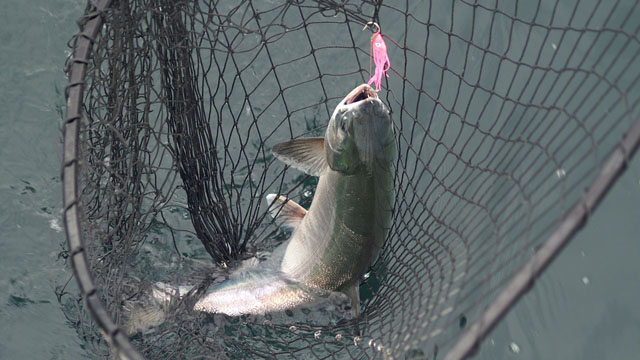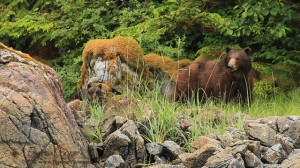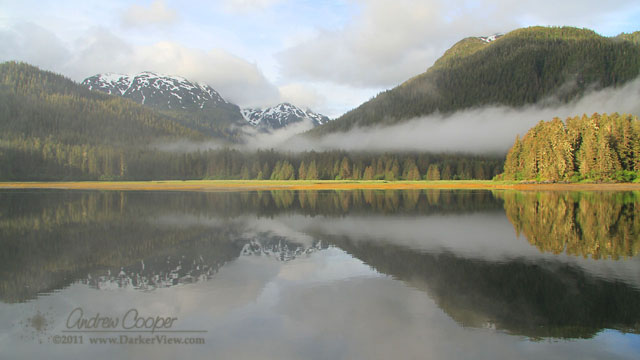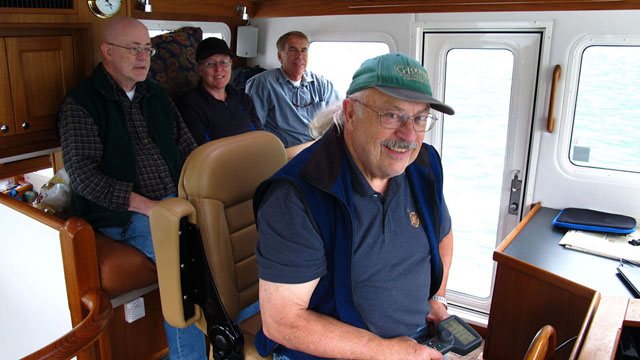
A netted salmon ready to be brought onboard, photo by Dawn Hubble

A netted salmon ready to be brought onboard, photo by Dawn Hubble
Any wildlife photographer knows that getting The Shot is all about planning and patience, and perhaps a little luck. Not much we can do about the luck part, sometimes the bear just walks away. But there are ways to improve the first two items.

A mother brown bear (Ursus arctos horribilis) and cub along the shoreline of Long Bay, photo by Andrew Cooper

Glassy water and morning fog as we get underway from Idaho Inlet, photo by Andrew Cooper
Blog posts just read better when a photo is included. While a psychologist might argue, my guess is that the effect of a photo is due to our visually oriented minds. We simply like photos, the images give an immediate context for the article that is processed before we even complete reading the first sentence.
The photo can be anywhere in the posting, to either side, across the bottom, as long as it is visible with the top of the article. It helps if the blog layout is clean, without too much visual clutter from other images or advertisements. Even worse is a background image that distracts from the primary article and images.
The extreme example are blogs that include a photo no matter the subject. One of my favorites is Photo Attorney by lawyer Carolyn Wright. This is a great blog covering the legal aspects of copyright law and the business of photography. Carolyn often includes a photo with every post. And while the post covers some legal aspect of photography the image is usually a dramatic wildlife photo taken by Carolyn. The juxtaposition is sometimes interesting, hawks or lions while talking about courts and plantiffs. There is no denying the effect of the photo, you just want to read the posting.
We will make it a practice to include a photo in most of our postings. Even if it means reusing a photo that has been published before. After a while any blog begins to accumulate quite a collection of photographs. This provides a ready set of “stock” photos which can be used to illustrate any posting.
There was one big reason I was aboard a Nordic tug with Cap’n Fred out of Clover Pass a couple years back. That was because he almost guaranteed we would tie into some Silver salmon. “For sure, the silvers will be running,” he told me. Hearing that, I went on-line and bought an out-of-state fishing license and my airline ticket from Seattle to Alaska. Once we’d stocked up on supplies and frozen herring in Ketchikan and headed across Behm Canal for Camano Point, it felt really good to be back in SE Alaska.
Naturally, I was looking forward to potential photo op encounters with wild life: killer whales, seals, sea lions, bald eagle, osprey, bears, and off-camera with mosquitoes, ticks, and deer flies. Yet what I really wanted to re-experience was the thrill of trolling, a fishing pole in my hands, feeling a nudge at the slice of herring at the end of my line, then setting the hook and having a wild salmon bending my pole like a bow, fighting for its life, the line zinging off the reel. The energy surge of battling a strong salmon, yao, now you’re talking pure wildness.
There are times when you’re fishing on an in-coming tide, and you can visually see where the schools of anchovies are pooling, their silvery flashes, and you know salmon are after them. But dang if you can entice one of those salmon to chase after the lovely silver flash of herring you have on your hook. So, how do you summon a salmon?
You get inventive. I can clearly recall standing at the stern of the boat with my cousin Ben, our feet (his bare) spread for balance, Cap’n Fred at the helm, as we were trolling, four lines in the water, all poles in their holders, when the two of us spontaneously started doing a native chant. The chant had a great “hiya hiya hiya” resonance welcoming the silvers to strike. And strike they did! Within minutes there was an energy-charged time when the clickers on all four lines went zinging and we had to call out, “Come grab a pole!”
Granted, there were also times we experienced some wildness that you want only to be an distant observer of. The supreme highlight being a close-up (within 20 ft of the boat!) of three humpback whales coordinating a ‘bubble feed’ where they dove down in unison, exhaled a huge amount of oxygen from below to corral and confuse their prey (thrill the krill for the kill), then came surging up with mouths wide open to scoop up lunch and lunge their huge bodies into the sky. Watching this happen, I was so transfixed, I forgot I had a camera. I took not a single picture. Could’ve taken video. Dang!
Along on this quest was Cap’n Fred’s friend Dan Green as co-captain/navigator and, it turns out, gun-bearer. Guns, bears, hey, this is Alaska. And there were some days we didn’t fish, we cruised. One of those days we cruised into Margaret Bay off Behm Canal where the Forest Service has a float-dock and where we tied up for an afternoon to get our shore-legs back. We planned to hike a couple miles up-stream to a bear-watching observation platform built above a set of cascading waterfalls and fish ladder on Margaret Creek. Scuttlebutt had it that pinks were running thick upstream, and there would be bears aplenty.
As we left the dock in Margaret Bay behind, Dan called our little group together in a huddle to confirm that we might well meet a bear at any time. And that he was packing heat. “I admit, it was only a .38 caliber. Not much firepower, and as they say, firing less than a .45 caliber at a charging bear will probably only be helpful in marking the bear that got you.” I started wondering if we should sing as we hiked along the road and trail to kind of announce ourselves. I thought of suggesting we sing ‘we’ll be coming round the mountain when we come, when we come, and we’ll be packing .38 specials as we come ..’. But then again, I didn’t want to make light of meeting a bear.
“Just remember,” Dan continued, “if there is an encounter, keep cool, no running. We bunch up in a group and try to look big.” And off we went into the forest. Just days earlier we had seen a big mama brown bear and her two cubs cross a gravel bar at the mouth of the stream we’d anchored off. So, I was greatly relieved to hear Dan mention we were now in black bear country. It was highly unlikely that a black bear would approach us. As it happened, the closest we got to encountering a bear was when two young ones wrestled over a flopping fish right below the observation platform. They either couldn’t see us or they ignored us. After all, we were safely hidden behind a canvas shelter on the viewing post, peeking through window flaps. We watched black bear fish from the rocks while bald eagles fished from the sky. If one’s quest for observing wildlife included the cycle of life and death, Margaret Creek near Ketchikan certainly is one place for it.
All cruising done, all fish flash-frozen at Clover Pass, Cap’n Fred took us back to Ketchikan. And that gave us a day to go exploring the zig-zag maze of wooden walkways above Ketchikan Creek, once the town’s red light district, with spawn-ready sockeyes turning red in the stream below us.
Now that’s pretty wild, right?
Vintage film of Ketchikan via Ellis Air
Andrew Jensen in his blog of December 12,2011 for the Alaska Journal of Commerce reported – the North Pacific Fishery Management Council adopted management guidance for the International Pacific Halibut Commission for the charter sector in 2012. In Area 2C, or Southeast Alaska, the council recommended IPHC drop the 37-inch size limit it put in place for 2011. Instead, the council adopted guidance for a reverse slot limit. Charter anglers may retain any fish up to 45 inches and shorter, or those 68 inches or longer. Any fish between 45 inches and 68 inches may not be retained. The measure is designed to give some relief from the 37-inch limit which kept the 2C charter sector some 390,000 pounds under its harvest limit of 788,000 pounds in 2011. Under a one fish of any size bag limit in 2010, 2C charter anglers landed fish averaging 26 pounds and non-charter fish averaged 16.9 pounds. Under the 37-inch size limit enforced for 2011, the average weight for charter caught fish dropped to 9.4 pounds, while non-charter fish averaged 16.4 pounds. Charter operators advocated for the reverse slot limit to allow for marketing a trophy opportunity, which will benefit ports such as Gustavus and Petersburg the most.
The IPHC will meet in Anchorage on January 24-27, 2012. No changes in the regulations for non-charter anglers have been proposed. We will try to monitor and provide more information later.

Fred Cooper at the helm of the Nordic Quest
Here is a recipe for Dungeness crab cakes that my cruising guests beg for:
Melt the butter in a small saute pan over medium heat. Add the onions, celery and bell peppers. Season with salt and cayenne. Cook, stirring, until the vegetables are soft and slightly golden, about 5 minutes. Add the garlic and cook, stirring, for another 2 minutes. Set aside and let cool for 5 minutes.
In a large mixing bowl, combine the crab meat, green onions, cheese, parsley, mayonnaise, and 3/4 cups of the bread crumbs. Add the mixed vegetables and mix well. Divide the mixture into 10 equal portions and form them into 3/4-inch-thick cakes (patties). In a small bowl, whisk the egg with the water. In a second bowl, place the remaining 3/4 cup bread crumbs.
Heat the 1 cup of oil to 360 degrees in a large saute pan over medium-high heat. Dredge the cakes first in the flour, tapping off any excess, then in the egg wash, letting the excess drip off. Dredge the cakes in the seasoned breadcrumbs, coating them evenly. Gently lay the cakes, 3 to 4 at a time, in the oil and fry until lightly golden, about 4 minutes on each side. You can serve immediately or place in a warming pan until all of your guests can be served.
Welcome to the world of the Nordic Quest and cruising in SE Alaska. This site is dedicated to seeking adventure and exploring the wonders of this fascinating region. As the owner of the Nordic Quest, a 42-foot Nordic Tug that was launched in April 2011, I want to share information about interesting places I have visited throughout Southeast Alaska, some of the history of its places, what can be seen at different times of the year, great places to fish, or just plain explore like I have done for over twenty five years. The site will have information for boaters – good anchorages and poor, places that will really make your trip special. SE Alaska is a unique area of the United States and much of it is only accessible by boat. So enjoy the features of this site and come back often as there will always be something new in our blogs and special features to share with our readers whether they are planning their first trip, another trip with their own vessel or chartering the Nordic Quest.
It is a quiet place today, a favorite anchorage near Juneau for local sportsman and boaters, rimmed with a dozen homes and cabins. Funter Bay is a convenient place to stop and spend the night for anyone coming into or out of Juneau and Auke Bay. No surprise that we found ourselves using this safe anchorage no less than four times over two weeks. As I have come to find, it is more than a convenient harbor, it is also a very interesting place…
At the beginning of the 20th century, Funter Bay was home to a large cannery and mining operations. Photos from 1900 to 1930 show a bay alive with activity, with substantial buildings supporting the mine and cannery, a post office, church and everything else one would expect in a thriving community. The area has quite a history with tales of industry and tragedy. The stories are a vignette of Alaskan history that typifies the lives of those who came to this place generations ago.
Even with a quick exploration of the area, signs of the past are scattered about to catch an observant eye and inquisitive mind. Pilings on the shoreline, unnatural objects along the beach. Going ashore and poking about soon reveals that the forest conceals even more evidence that this bay looked much different in the past.
Just behind the treeline of Coot Cove are four barges, well built working vessels now decaying in the woods. the decks are collapsing and spruce trees grow through the frames. Remains of a skid ramp and heavy cables secured to large tree stumps show how they came to rest here well above the tideline. Two large motors and winch gear are rusting away on the uppermost barge.